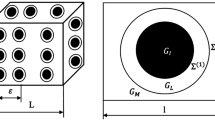Abstract
The present paper deals with the homogenization problem of periodic composite materials, considering a Cosserat continuum at the macro-level and a Cauchy continuum at the micro-level. Consistently with the strain-driven approach, the two levels are linked by a kinematic map based on a third order polynomial expansion. Because of the assumed regular texture of the composite material, a Unit Cell (UC) is selected; then, the problem of determining the displacement perturbation fields, arising when second or third order polynomial boundary conditions are imposed on the UC, is investigated. A new micromechanical approach, based on the decomposition of the perturbation fields in terms of functions which depend on the macroscopic strain components, is proposed. The identification of the linear elastic 2D Cosserat constitutive parameters is performed, by using the Hill–Mandel technique, based on the macrohomogeneity condition. The influence of the selection of the UC is analyzed and some critical issues are outlined. Numerical examples for a specific composite with cubic symmetry are shown.



















Similar content being viewed by others
References
Addessi D, De Bellis ML, Sacco E (2013) Micromechanical analysis of heterogeneous materials subjected to overall cosserat strains. Mech Res Commun 54:27–34
Addessi D, Sacco E (2012) A multi-scale enriched model for the analysis of masonry panel. Int J Solids Struct 49:865–880
Anthoine A (1995) Derivation of the in-plane elastic characteristics of masonry through homogenization theory. Int J Solids Struct 32(2):137–163
Bacigalupo A (2014) Second-order homogenization of periodic materials based on asymptotic approximation of the strain energy: formulation and validity limits. Meccanica 49(6):1407–1425
Bacigalupo A, Gambarotta L (2010) Second-order computational homogenization of heterogeneous materials with periodic microstructure. ZAMM Z Angew Math Mech 90(10–11):796–811
Bacigalupo A, Gambarotta L (2012) Computational two-scale homogenization of periodic masonry: characteristic lengths and dispersive waves. Comput Method Appl Mech 213–216:16–28
Bacigalupo A, Gambarotta L (2013) Multi-scale strain-localization analysis of a layered strip with debonding interfaces. Int J Solids Struct 50:2061–2077
Bakhvalov N, Panasenko G (1989) Homogenisation: averaging processes in periodic media. Mathematical problems in the mechanics of composite materials. Springer, New York
Bigoni D, Drugan WJ (2007) Analytical derivation of Cosserat moduli via homogenization of heterogeneous elastic materials. J Appl Mech 74:741–753
Boutin C (1996) Microstructural effects in elastic composites. Int J Solids Struct 33(7):1023–1051
Bouyge F, Jasiuk I, Boccara S, Ostoja-Starzewski M (2002) A micromechanically based couple-stress model of an elastic orthotropic two-phase composite. Eur J Mech A Solid 21:465–481
Bouyge F, Jasiuk I, Ostoja-Starzewski M (2001) A micromechanically based couple-stress model of an elastic two-phase composite. Int J Solids Struct 38:1721–1735
De Bellis M, Addessi D (2011) A Cosserat based multi-scale model for masonry structures. Int J Multiscale Comput 9(5):543–563
Feyel F (2003) A multilevel finite element method (fe2) to describe the response of highly non-linear structures using generalized continua. Comput Method Appl Mech 192:3233–3244
Forest S (1998) Mechanics of generalized continua: construction by homogeneization. J. Phys. IV France 8
Forest S, Sab K (1998) Cosserat overall modeling of heterogeneous materials. Mech Res Commun 25:449–454
Forest S, Trinh D (2011) Generalized continua and non-homogeneous boundary conditions in homogenisation methods. ZAMM Z Angew Math Mech 91(2):90–109
Kaczmarczyk L, Pearce C, Bicanic N (2008) Scale transition and enforcement of rve boundary conditions in second-order computational homogenization. Int J Numer Methods Eng 74:506–522
Kouznetsova V, Geers M, Brekelmans W (2004a) Multi-scale second-order computational homogenization of multi-phase materials: a nested finite element solution strategy. Comput Method Appl Mech 193:5525–5550
Kouznetsova VG (2002) Computational homogenization for the multi-scale analysis of multi-phase materials. Ph.D. thesis, Technische Universiteit Eindhoven
Kouznetsova VG, Geers MGD, Brekelmans WAM (2004b) Size of a representative volume element in a second-order computational homogenization framework. Int J Multiscale Comput Eng 2:575–598
Li J (2011) A micromechanics-based strain gradient damage model for fracture prediction of brittle materials part I: homogenization methodology and constitutive relations. Int J Solids Struct 48(24):3336–3345
Miehe C (2002) Strain-driven homogenization of inelastic microstructures andcomposites based on an incremental variational formulation. Int J Numer Methods Eng 55:1285–1322
Sánchez-Palencia E (1980) Non homogeneous media and vibration theory, vol 127 of Lecture Notes in Physics. Springer, Berlin
Sanchez-Palencia E (1987) Boundary layers and edge effects in composites. In: Sánchez-Palencia E, Zaoui A (eds.) Homogenization techniques for composite media. Lecture notes in physics 272. Springer, Berlin, p 121–192
Smyshlyaev VP, Cherednichenko K (2000) On rigorous derivation of strain gradient effects in the overall behaviour of periodic heterogeneous media. J Mech Phys Solids 48:1325–1357
Suquet P (1987) Elements of homogenization for inelastic solid mechanics. In: Sánchez-Palencia E, Zaoui A (eds.) Homogenization Techniques for Composite Media. Lecture Notes in Physics 272. Springer, Berlin, p 193–278
Taylor R (2011) FEAP-A finite element analysis program, Version 8.3. Department of Civil and Environmental Engineering, University of California at Berkeley, California
Tran TH, Monchiet V, Bonnet G (2012) A micromechanics-based approach for the derivation of constitutive elastic coefficients of strain-gradient media. Int J Solids Struct 49:783–792
Trovalusci P, Masiani R (2003) Non-linear micropolar and classical continua for anisotropic discontinuous materials. Int J Solids Struct 40(5):1281–1297
van der Sluis O, Schreurs PJG, Brekelmans WAM, Meijer HEH (2000) Overall behaviour of heterogeneous elastoviscoplastic materials: effect of microstructural modelling. Mech Mater 32:449–462
van der Sluis O, Vosbeek PHJ, Schreurs PJG, Meijer HEH (1999) Homogenization of heterogeneous polymers. Int J Solids Struct 36:3193–3214
Yuan X, Tomita Y, Andou T (2008) A micromechanical approach of nonlocal modeling for media with periodic microstructures. Mech Res Commun 35(1–2):126–133
Author information
Authors and Affiliations
Corresponding author
Rights and permissions
About this article
Cite this article
Addessi, D., De Bellis, M.L. & Sacco, E. A micromechanical approach for the Cosserat modeling of composites. Meccanica 51, 569–592 (2016). https://doi.org/10.1007/s11012-015-0224-y
Received:
Accepted:
Published:
Issue Date:
DOI: https://doi.org/10.1007/s11012-015-0224-y




